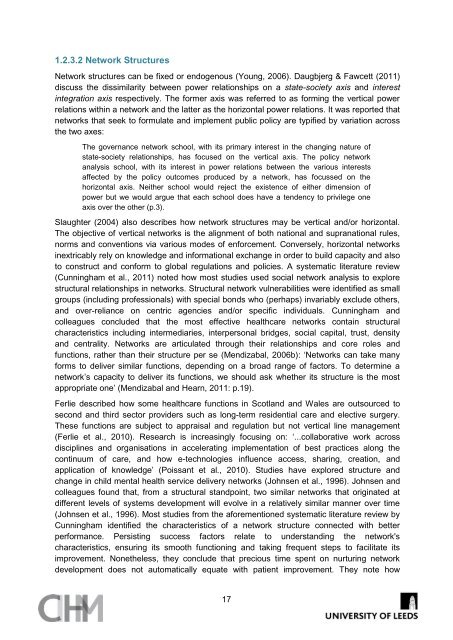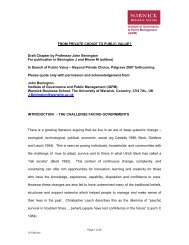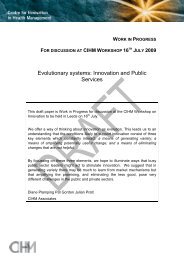Networks - a briefing paper for the Health Foundation - Centre for ...
Networks - a briefing paper for the Health Foundation - Centre for ...
Networks - a briefing paper for the Health Foundation - Centre for ...
- No tags were found...
You also want an ePaper? Increase the reach of your titles
YUMPU automatically turns print PDFs into web optimized ePapers that Google loves.
1.2.3.2 Network StructuresNetwork structures can be fixed or endogenous (Young, 2006). Daugbjerg & Fawcett (2011)discuss <strong>the</strong> dissimilarity between power relationships on a state-society axis and interestintegration axis respectively. The <strong>for</strong>mer axis was referred to as <strong>for</strong>ming <strong>the</strong> vertical powerrelations within a network and <strong>the</strong> latter as <strong>the</strong> horizontal power relations. It was reported thatnetworks that seek to <strong>for</strong>mulate and implement public policy are typified by variation across<strong>the</strong> two axes:The governance network school, with its primary interest in <strong>the</strong> changing nature ofstate-society relationships, has focused on <strong>the</strong> vertical axis. The policy networkanalysis school, with its interest in power relations between <strong>the</strong> various interestsaffected by <strong>the</strong> policy outcomes produced by a network, has focussed on <strong>the</strong>horizontal axis. Nei<strong>the</strong>r school would reject <strong>the</strong> existence of ei<strong>the</strong>r dimension ofpower but we would argue that each school does have a tendency to privilege oneaxis over <strong>the</strong> o<strong>the</strong>r (p.3).Slaughter (2004) also describes how network structures may be vertical and/or horizontal.The objective of vertical networks is <strong>the</strong> alignment of both national and supranational rules,norms and conventions via various modes of en<strong>for</strong>cement. Conversely, horizontal networksinextricably rely on knowledge and in<strong>for</strong>mational exchange in order to build capacity and alsoto construct and con<strong>for</strong>m to global regulations and policies. A systematic literature review(Cunningham et al., 2011) noted how most studies used social network analysis to explorestructural relationships in networks. Structural network vulnerabilities were identified as smallgroups (including professionals) with special bonds who (perhaps) invariably exclude o<strong>the</strong>rs,and over-reliance on centric agencies and/or specific individuals. Cunningham andcolleagues concluded that <strong>the</strong> most effective healthcare networks contain structuralcharacteristics including intermediaries, interpersonal bridges, social capital, trust, densityand centrality. <strong>Networks</strong> are articulated through <strong>the</strong>ir relationships and core roles andfunctions, ra<strong>the</strong>r than <strong>the</strong>ir structure per se (Mendizabal, 2006b): ‘<strong>Networks</strong> can take many<strong>for</strong>ms to deliver similar functions, depending on a broad range of factors. To determine anetwork’s capacity to deliver its functions, we should ask whe<strong>the</strong>r its structure is <strong>the</strong> mostappropriate one’ (Mendizabal and Hearn, 2011: p.19).Ferlie described how some healthcare functions in Scotland and Wales are outsourced tosecond and third sector providers such as long-term residential care and elective surgery.These functions are subject to appraisal and regulation but not vertical line management(Ferlie et al., 2010). Research is increasingly focusing on: ‘...collaborative work acrossdisciplines and organisations in accelerating implementation of best practices along <strong>the</strong>continuum of care, and how e-technologies influence access, sharing, creation, andapplication of knowledge’ (Poissant et al., 2010). Studies have explored structure andchange in child mental health service delivery networks (Johnsen et al., 1996). Johnsen andcolleagues found that, from a structural standpoint, two similar networks that originated atdifferent levels of systems development will evolve in a relatively similar manner over time(Johnsen et al., 1996). Most studies from <strong>the</strong> a<strong>for</strong>ementioned systematic literature review byCunningham identified <strong>the</strong> characteristics of a network structure connected with betterper<strong>for</strong>mance. Persisting success factors relate to understanding <strong>the</strong> network'scharacteristics, ensuring its smooth functioning and taking frequent steps to facilitate itsimprovement. None<strong>the</strong>less, <strong>the</strong>y conclude that precious time spent on nurturing networkdevelopment does not automatically equate with patient improvement. They note how17
















